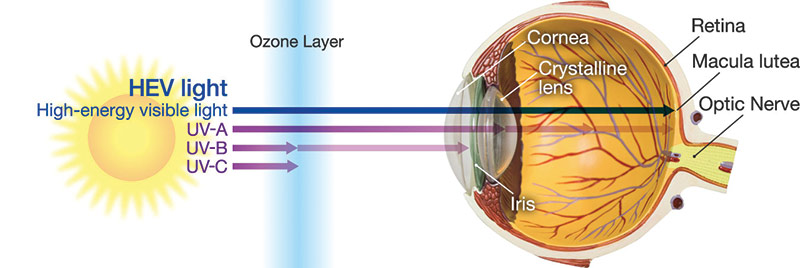Sponsored by Mitsui Chemicals
By Preston Fassel, ABOC

Over a decade ago, we were introduced to the hazards of blue light exposure to the eye. Alarms were raised, and misinformation abounded. Thankfully, the intervening years have provided us with a wealth of research data and knowledge to better educate ourselves and our patients on the role HEV blue light plays relative to glare and potentially harmful retinal effects. Ultraviolet and HEV blue light are high-energy electromagnetic wavelengths with the potential to cause damage to the human eye. The primary source of excess exposure to UV and HEV comes from the sun. In terms of eye health and vision, UV provides no benefits: Repeated long-term exposure damages ocular tissue and cells, contributing to the development of cataracts and other eye health concerns.
Similarly, HEV blue light has the potential to elicit a photochemical reaction that may result in retinal damage. But as ECPs, we should all be aware that beneficial blue light does exist, and exposure to these long blue wavelengths (approximately 460 to 469 nm) sets our circadian rhythm (biological clock). So yes, we want to filter the harmful rays while allowing the transmission of the beneficial rays.
HEV blue light comprises wavelengths between the 400 to 455 nm range (some reference 380 to 455 nm). HEV is adjacent to ultraviolet radiation on the electromagnetic spectrum, with energy levels just below UVA. HEV blue light consists of visible blue-violet wavelengths which transmit through the lens to the retina. Light in the 400 to 420 nm part of the spectrum is thought to be particularly harmful. Experiments carried out by Professor Richard Funk of the Technical University of Dresden have demonstrated that short wavelength light of 411 nm shows indications of cell death. Damage and its extent depend on how much blue light the eye absorbs and the wavelengths, different wavelengths damage different eye parts. In “Light-Induced Damage to the Retina,” Rozanowski et al., show that photoreceptor cells are most sensitive to damage from invisible UV and the shortest visible blue from 400 to 440 nm, while retinal pigment epithelial (RPE) cells are most susceptible to damage from 440 to 467 nm. While blue light concerns inspired numerous products intended to block as much blue light as possible, we need exposure to beneficial blue light from the 460 to 490 nm part of the spectrum. This blue light regulates circadian rhythms by triggering the release of serotonin and other brain chemicals, telling us when to wake in the morning, and when it’s time to sleep at night. In nature, before the rise of artificial lighting, higher exposure from the morning sun encouraged wakefulness, while dropping levels at sunset increased melatonin, inducing sleep. However, artificial blue light from digital devices can cause dysregulation in our digital age, and for maximum sleep quality, avoiding digital screen exposure for two to three hours before bedtime is recommended.
With this in mind, how do we reduce UVR and HEV blue light exposure in our everyday clear lenses without sacrificing cosmetics? Ask your lab for blue filter lenses made with UV+420cut™ technology by Mitsui Chemicals. The technology filters UV and HEV up to 420 nm while transmitting longer blue wavelengths and the rest of the visible light spectrum. With UV+420cut™ technology, specially treated dye with UV and HEV blue filters are added to the lens material (in-mass). This is an improvement over surface coatings in that the lens lasts longer (because scratches to the surface do not degrade their function). In-mass technology differs from the HEV blue light filters that use reflection to lower the transmission of blue light, giving off the tell-tale blue reflection. Also, lenses with UV+420cut™ technology do not have an unappealing yellow hue that can affect color perception, often seen in blue filtering lenses. So, those lenses protect us from actinic UV and HEV light without altering the colors we see. Lenses made with UV+420cut™ technology by Mitsui Chemicals are one of the most aesthetically pleasing, durable lenses to reduce UV and HEV light exposure while allowing beneficial visible wavelengths to transmit.
Reducing lifetime exposure to actinic light (UVR and HEV blue) is a precaution against ocular injury and damage from the phototoxicity of high-energy wavelengths. Protective lenses can help accomplish this goal. Mitsui Chemicals’ UV+420cut™ is a clear lens technology that cuts HEV blue light in the 400 to 420 nm spectrum, in addition to blocking UV radiation, thereby enhancing protection in clear everyday lenses against the types of light that can damage the eyes.
Learn more about the lenses made with UV+420cut™ technology by Mitsui Chemicals in our CE, “Let’s Be Clear About Blue” at 2020mag.com.












